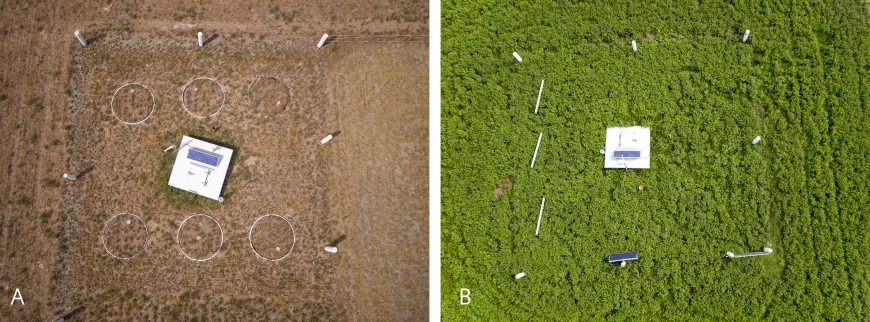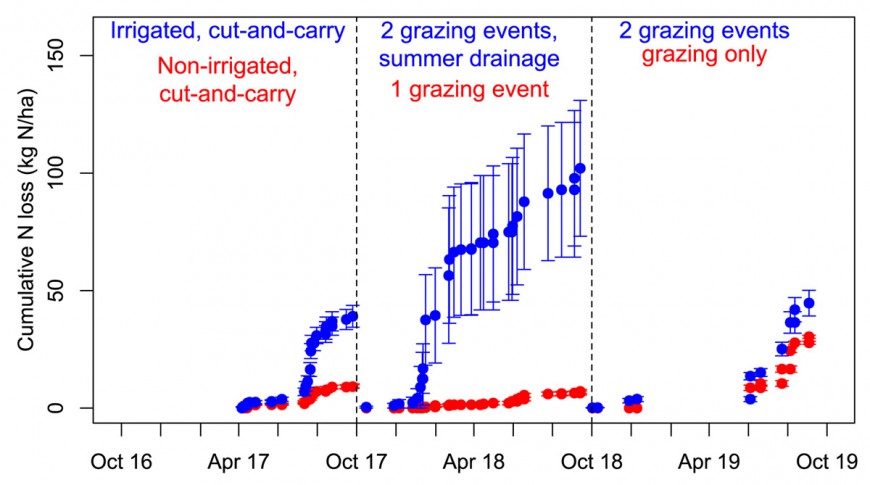Lysimeter research identifying management practices to reduce nitrogen leaching
As part of an MBIE Endeavour programme Reducing nitrogen losses from farms, 12 large lysimeters were installed at the Ashley Dene Research & Development Station near Lincoln in the spring of 2016 (Fig. 1A, B). These lysimeters are 2 m in diameter and 1.5 m deep, containing a soil volume more than 30 times greater than other lysimeters typically used in New Zealand. The large lysimeters allow for measurement of drainage and leaching from forages including deep-rooted species and inputs of animal excreta in natural patch sizes, with reduced edge effects relative to smaller lysimeters.

Figure 1: Aerial photographs of lysimeters planted with lucerne under non-irrigated (A) and irrigated (B) conditions at the Ashley Dene Research & Development Station during a summer drought period.
We now have more than 3 full years of drainage and leaching measurement from lucerne, a deep-rooted N fixing species, under a range of weather and management conditions. Key findings of this work are that N leaching losses from non-irrigated lucerne grown for cut-and-carry feed are typically low, 7–9 kg N/ha/y, but losses are 1.5–15 times greater when irrigated with water and effluent (Fig. 2). Continuous grazing also leads to N losses three times greater than those for cut-and-carry management.

Figure 2: Nitrogen leaching losses from non-irrigated lucerne (red) and lucerne irrigated with water and effluent (blue) over 3 full years; management features are noted for each year.
Greater N leaching losses from irrigated lucerne are due, in part, to the larger drainage volumes resulting from irrigation. Organic forms of N have a relatively constant concentration in leachate. Increased drainage leads to increased loss, which our measurements have shown to be true for phosphorus and carbon leaching as well. Leaching of inorganic N as nitrate, more relevant for environmental and human health impacts, is driven by external inputs of N through excreta and effluent addition. In addition to quantity, the timing of soil drainage also contributes to the N loss (Fig. 2), for example, losses of 60 kg N/ha were observed at the irrigated site during drainage events following heavy summer rainfall. These N losses exceeded the remaining months of the year and annual totals for other measurement years. These summer events, which occurred outside the normal winter drainage season, were caused by two large rain events on top of an already high soil water content from irrigation and did not occur in the non-irrigated lucerne.
The implications of our findings for farm management are that lucerne is not effective for mitigating N losses from animal excreta and effluent, losing as much N as a typical fertilised ryegrass clover pasture. Our results also indicate potential for reduction of N leaching, as additional drainage and summer drainage events were the result of irrigation and could be minimised through improved water management practices, such as deficit irrigation.
We are now in the process of converting the lysimeters from lucerne to mixed species pasture, including winter-active species, additional legumes, deep-rooted species, and plantain. This will give us important information on the legacy effects of the lucerne crop, which releases N as the residual below-ground biomass decomposes. We will also determine the potential for the new mixed species pasture to increase N uptake by increasing winter growth, rooting depth, and N retention with other biological mechanisms, leading to reduced N losses relative to a typical ryegrass clover pasture or monoculture forage crop.
Further reading
Laubach J, Hunt JE, Graham SL, Buxton RP, Rogers GND, Mudge PL, Carrick S, Whitehead D 2019. Irrigation increases forage production of newly established lucerne but enhances net ecosystem carbon losses. Science of The Total Environment 689: 921–936.
https://doi.org/10.1016/j.scitotenv.2019.06.407
Gray CW, McDowell RW, Graham SL, Hunt JE, Laubach J, Rogers GND, Carrick S, Whitehead D 2020. Phosphorus transport in subsurface flow from a stony soil under irrigated and non-irrigated lucerne. New Zealand Journal of Agricultural Research, in press.
https://doi.org/10.1080/00288233.2020.1792514
Key contacts

Scott Graham

Johannes Laubach


